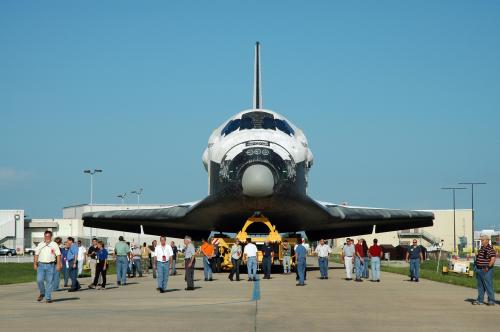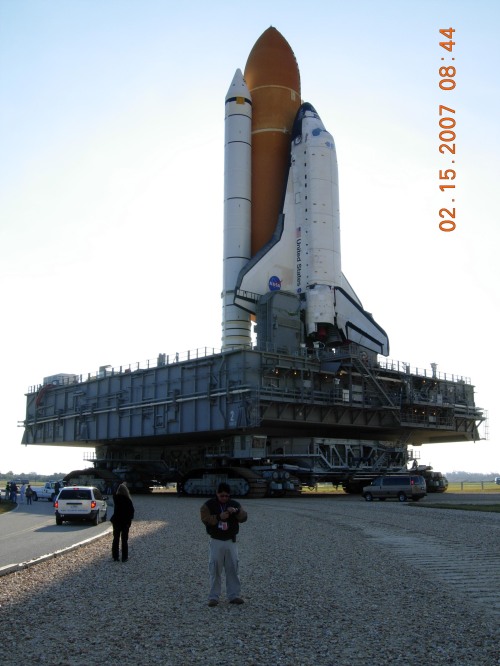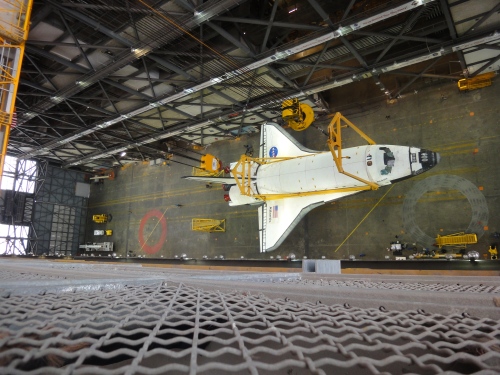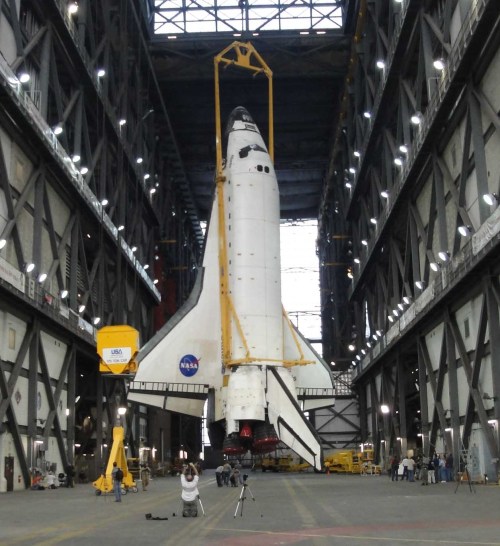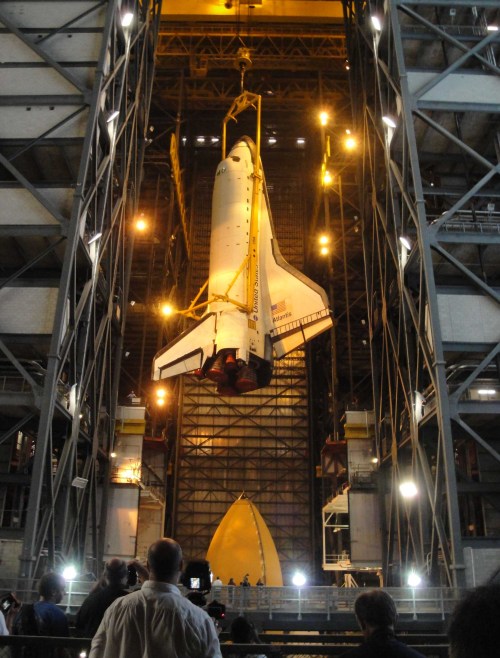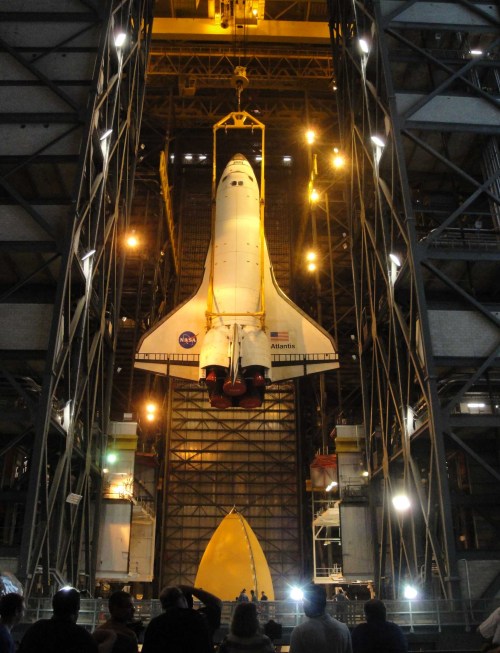Arguably the night of May 31 / June 1, 2011, will go down as one of the greatest nights in the shuttle program. In the evening the final shuttle mission continued toward launch with the rollout of the shuttle Atlantis from the Vehicle Assembly Building.
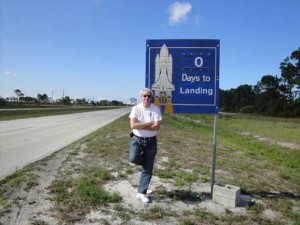
Game on! The sign tells it all -- behind Pete to the left is the landing field. Endeavour is coming home tonight, but that's not all that will happen tonight at the Cape.
Before the Atlantis arrived at Pad 39-A, hours later, Endeavour slipped out of orbit 200 miles above the Earth between the Indian Ocean and Ausralia and glided back to Earth for more than sixty minutes, landing at Kennedy at 2:32 am ending the second to last mission in the 30-year shuttle program.
Along the way there were interviews with the crew that will fly the last mission ever, and opportunities to photograph the Atlantis at 39-A as the sun rose over her, and as the sun was setting on the American shuttle program itself.
By dawn, June 1, 2011, the second to last shuttle mission was over, and the final mission, STS-135, was on the launch pad, poised ready to begin. Lift-off is scheduled no earlier than July 8, 2011 — but there is talk of bumping the launch up to July 4.
The following 25 photographs, taken between 4 pm and 4 am, document only a part of this remarkable evening and morning at the Cape.
.

The Vehicle Assembly Building, diagram. Let's get oriented -- where are we going? Here's your floor plan of the Vehicle Assembly Building. First we'll enter the Transfer Aisle from the "you are here" at bottom of the diagram walking first forward through Areas K, L, M and N, largely storage areas, albeit it huge ones. Straight ahead is the door through which the shuttles entered when being brought over from their hangars. Inbetween us, and the Transfer Aisle are Areas K,L,M and N, the ceiling of the VAB, while high, is much lower. and then we'll turn into High Bay 1 between Towers D and E. Here our photographs will be on the ground floor, 4th floor, 5th floor and 16th floor. All locations in the photographs will be identified. The VAB is 37 floors, roughly 500 feet, but the shuttle only reaches to about th 16th floor. During the Apollo Moon program in the 1960s and early 1970s, all of the height of the VAB was required to assemble the Apollo rockets.
.
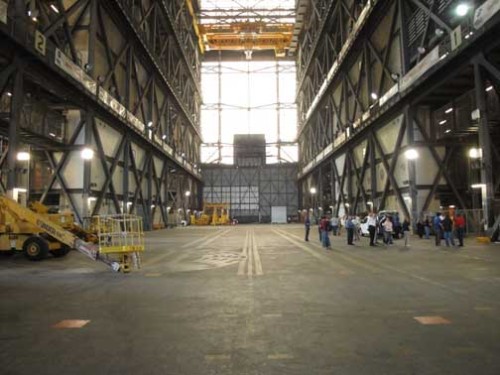
The Vehicle Assembly Building, main floor. The main hallway of the Vehicle Assembly Building where only 10 days before the Atlantis was wheeled in, turned upright and lifted 500 feet up, and then back down, and placed on the crawler that tonight and tomorrow morning will carry her to Pad 39-A, and on to space.
.
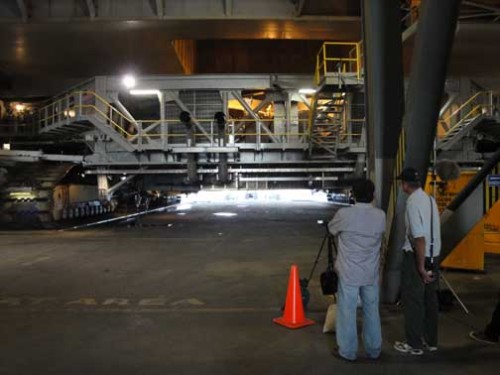
The Vehicle Assembly Building, main floor. This is the Crawler -- slow but steady. Once it begins moving it is about 6 hours from VAB to Pad 39-A, a distance of a few miles that is transversed on a roadway of small river rock.
.

The Vehicle Assembly Building, 5th floor. The Crawler upper deck. The media herded between the main level, and floors 4, 5 and 16. A lack of personnel, and a growing disdain for the media by all but a few of the Kennedy Space Center personnel has created problems, perhaps compounded by the difficulty of sorting out legitimate media in an era of bloggers and decreased resources of traditional media such as daily newspapers and television networks.
.

The Vehicle Assembly Building, 5th floor. Isn't she beautiful. The Atlantis perched and secured atop the Crawler. The shuttles are breathtaking, the closer you are to them, and the more you learn about these remarkably engineering machines, the more in awe are you of the men and women who built them, serviced and protected them, and flew them.
.

The Vehicle Assembly Building, 16th floor. , and through the window is the crawlway. That is not a two-lane divided highway you are looking at. The crawler's giant paws run are on each of that grassy divider and, by the way, they need the room. In a few moments, the crawler and Atlantis will head out onto what appears to be a four lane divided interstate. It's no interstate. This road is a one way crawlway for the shuttle.
.

The Vehicle Assembly Building, 16th floor. In the distance is Launch Pad 39-A lighted, and beyond is the Atlantic Ocean. The launch pads are on the shore.
.

The Vehicle Assembly Building, 16th floor. Another view of the bay, looking downward from the 16th floor.
.

The Vehicle Assembly Building, 16th floor. Photographers lean forward over yawning openings in the assembly bays, often pointing their cameras straight down. On some levels they are allowed out onto even narrower catwalks on each side of the bay. Note the reenforcing of the walkway. The other side of this catwalk overlooks the Transfer Aisle.
.

The Vehicle Assembly Building, 16th floor. There is nothing clean, nor safe, about the VAB. The catwalks are narrow and the open spaces are, of necessity, huge. It is often dirty, as with this piece of electrical equipment from which the paint is chipping off. As someone said, "nobody's cleaned anything up in decades up here"
.

The Vehicle Assembly Building, 16th floor. Elevator shafts are guarded only by metal mesh. The VAB is an industrial facility, utilitarian, not meant to be pretty.
.

The Vehicle Assembly Building, 16th floor. Warning signs are everywhere in the VAB, in elevators, on catwalks, in the hallways.
.

.

Vehicle Assembly Building, 4th floor. Going .... When the crawler begins to move, the shuttle exits the VAB fairly quickly. The crawler is slow but steady and in minutes it is gone, the bay cleaned up and gates and fences re-erected.
.
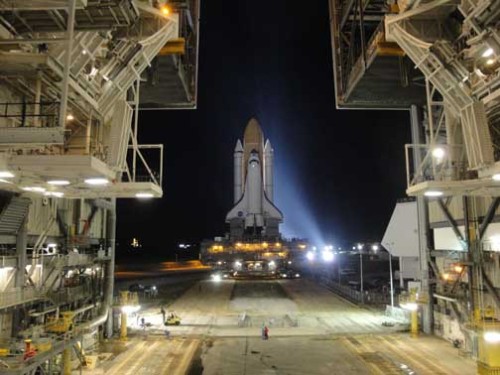
Vehicle Assembly Building, 4th floor. Going ... Once out of the VAB, the shuttle is bathed in light. Earlier in the program the shuttles were moved from the VAB to the Pad in the morning, but during the final launches, the shuttles were only moved at night. The press, often invited to walk along during the day to the pad, was barred during the final missions.
.

Vehicle Assembly Building, main floor. Gone! ... gates have been closed and the shuttle Atlantis has left the VAB for the final time, barring weather conditions that would require her to return for safety. The future of the VAB, the largest building in the world in terms of volume, is uncertain, but government officials are profiling the building for several companies that have expressed interest in acquiring the building. Who are they? No one will say, but word is three companies are interested.
.
.
.
The landing of the Endeavour, and the end of the second to last mission, STS-134.
With the final shuttle out of the VAB and another major step of the final shuttle mission, STS-135, accomplished, attention turned to the Shuttle Endeavour which had been at the International Space Station until two days before, and which was now preparing to land at Kennedy Space Center’s shuttle landing facility.
NASA began running the press buses the short distance to the SLF (shuttle landing facility) at 11:30 pm. Carol Anne caught the first bus.
Unlike the landing of Discovery in February, which was a daylight landing, this landing would be at 2:32 am — and, given the excellent weather conditions, it seemed likely that Endeavour would land on the first of its two landing opportunities. If it could not land, the Eneadavour would remain in orbit another day and would have two additional landing opportunities the fiollowing night. The landing opportunities have to do with the orbit tracks. Each time the shuttle orbits it tracks a slightly different course. Only a couple of those tracks are suitable for landing in Florida while other tracks are suitable for other landing sites such as White Sands, New Mexico and Edwards Air Force Base, California.
In February, we had photographed the landing from the north end of the SLF (shuttle landing facility = runway). Tonight we would photograph from mid-stride of the landing field at “The Tower” where there are grandstands and other facilities.
But reality was, on a largely moonless night, we would suspected that we would witness the landing of the Endeavour, but get nothing in terms of photographs. That proved to be true.
At 12:30 am I climbed in the second of two media buses and joined Carol Anne at the SLF. The weather was so favorable, the Endeavour was cleared to do its landing burn well in advance. She was coming home. The burn slows the speed of the shuttle from nearly 18,000 miles an hour causing it to slip out of orbit. By the time the shuttle lands sixty minutes following the de-orbit burn, she is flying at only 200 miles an hour.
The de-orbit burn is about 60 minutes before landing and takes place almost exactly on the other side of the world. This morning it was off India over the Indian Ocean near Australia. Once the de-orbit burn begins, the shuttle has no where to go except to the SLF in Florida. Her speed no longer sustains orbit.
After that burn for 60 minutes everyone waits knowing she is coming.
.

Shuttle Landing Field Tower at Kennedy Space Center. Grandstands for the media and VIPs are just below the tower. The tower is halfway down the runway known as the SLF, shuttle landing facility. The shuttle takes about 2/3s of the runway to land. The shuttle leaves orbit at 18,000 miles an hour about 220 miles up and touches down 60 minutes later at 200 mph at sea level.
.

Runway, shuttle landing field, Kennedy Space Center. TV and electronic media set up on the south side of the grandstand at the SLF. Nobody got much in the way of pictures when Endeavour landed because it was so dark.
.

Runway, shuttle landing field, Kennedy Space Center. The convoy which will service the shuttle after landing, tow her back to the hangars and pick up the astronauts, arrives about 30 minutes before landing and waits just off the runway midway down the field. The convoy uses the same road the media uses to get to the grandstand. Because of the size of the convoy, the media must, therefore, go to the grandstand area first. The convoy fills the road making further passage difficult. That's why, in spite of the grumbling, the final media buses to the SLF must leave the press site so early.
.

Runway, shuttle landing field, Kennedy Space Center. The media arrives as much as 3 hours before landing with little to do except lounge against walls or make phone calls. Internet and cellphone coverage is now excellent at the landing field unlike earlier days. With desks the media are able to work. Well, unless you are eaten by bugs. Bring bug spray when you come.
.

Runway, shuttle landing field, Kennedy Space Center. Work areas in the grandstand are surprisingly good, clean and well lighted. Views of the runway are also excellent in daylight or on nights with full moons.
.

Runway, shuttle landing field, Kennedy Space Center. The northern end of runway 15 where the shuttle was scheduled to land was well lit.
.

Runway, shuttle landing field, Kennedy Space Center. Tracking the shuttle and monitoring mission control in Houston was easy. Here I have the tracking on my iPhone which is logged onto http://www.nasa.gov, a superb web site. At this time the shuttle was approaching central America 42 miles above the earth.
.

Runway, shuttle landing field, Kennedy Space Center. The landing. You don't see anything? If you had been there you would have. The shuttle appears suddenly emerging out of the night fog and WHOOSHES by. It is breathtaking, but photography was impossible more sophisticated equipment and a much better vantage point. I have covered dozens of launches and landings in California and Florida. Itt never gets old. It gets me every time.
Here are some NASA photographs of the landing from better angles and better equipment.

NASA photograph of Endeavour landing, 1
.

NASA photograph of Endeavour landing, 2
. . . . . . . . . . . .
 .
.
.
.”petecrow/NASA” © 2011 by / Peter M. Crow and the Peter Michael Crow Trust and by Seine/Harbour® Productions, LLC, Studio City, California.
Read Full Post »




